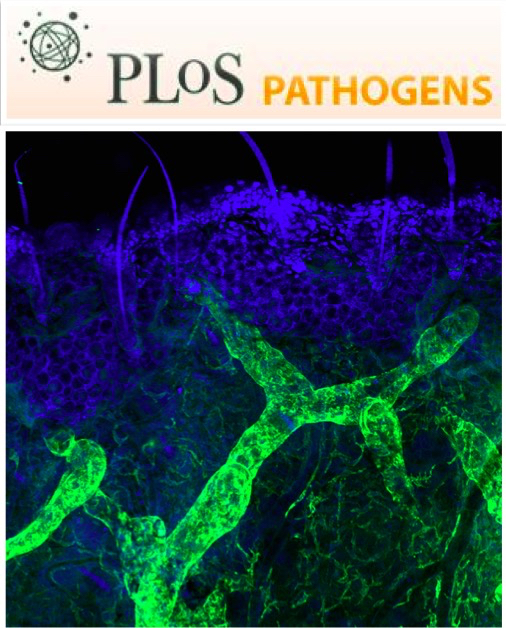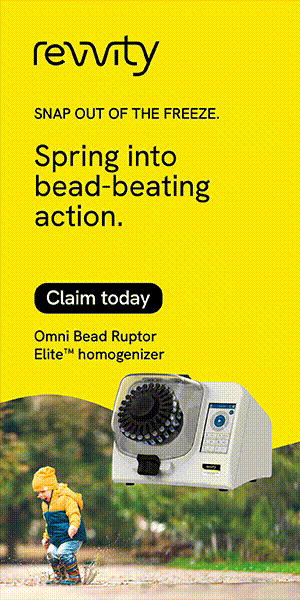- Submit a Protocol
- Receive Our Alerts
- Log in
- /
- Sign up
- My Bio Page
- Edit My Profile
- Change Password
- Log Out
- EN
- EN - English
- CN - 中文
- Protocols
- Articles and Issues
- For Authors
- About
- Become a Reviewer
- EN - English
- CN - 中文
- Home
- Protocols
- Articles and Issues
- For Authors
- About
- Become a Reviewer
5’ Rapid Amplification of cDNA Ends (5’ RACE) of Agrobacterial T-DNA Genes within Transformed Plant Sample
Published: Vol 5, Iss 18, Sep 20, 2015 DOI: 10.21769/BioProtoc.1603 Views: 12716
Reviewed by: Arsalan DaudiKanika GeraAnonymous reviewer(s)

Protocol Collections
Comprehensive collections of detailed, peer-reviewed protocols focusing on specific topics
Related protocols
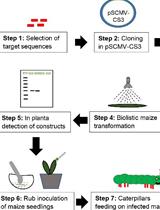
Inoculation of Maize with Sugarcane Mosaic Virus Constructs and Application for RNA Interference in Fall Armyworms
Iram Gull and Georg Jander
Jul 20, 2023 2171 Views
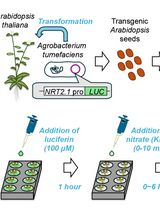
A Microplate-Based Expression Monitoring System for Arabidopsis NITRATE TRANSPORTER2.1 Using the Luciferase Reporter
Yoshiaki Ueda and Shuichi Yanagisawa
Dec 5, 2024 1747 Views
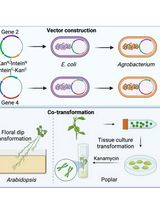
A Novel Gene Stacking Method in Plant Transformation Utilizing Split Selectable Markers
Guoliang Yuan [...] Xiaohan Yang
Feb 20, 2025 1943 Views
Abstract
The T-DNA (transferred-DNA) region of virulent Agrobacterium tumefaciens (A. tumefaciens) strain is transferred and integrated into the plant genome, and thereby the T-DNA genes are expressed in transformed plant cells. This protocol was used to analyze the transcription start sites (TSSs) of agrobacterial T-DNA genes within plant crown gall tumor. Firstly, the stems of Arabidopsis thaliana were inoculated by A. tumefaciens strain C58 and developed crown gall tumor. Subsequently, the mRNA was extracted from the crown gall tumor and then used for amplification of 5’ cDNA ends by 5’ Rapid Amplification of cDNA Ends (5’ RACE) assay. The full-length cDNAs were generated in reverse transcription reactions and used to analyze TSSs. Here, TSSs of three oncogenes, IaaH, IaaM and Ipt were analyzed as examples. This protocol also allows for identification of TSSs of the other agrobacterial T-DNA genes that expressed in plant cells.
Materials and Reagents
- A. tumefaciens strain C58 nocc (nopaline catabolism) (MAX-PLANCK-GESELLSCHAFT, catalog number: 584 )
- Arabidopsis thaliana Col-0
- Escherichia coli (E. coli) strain MRF’ (Agilent Technologies, catalog number: 200230-41 )
- Dynabeads® Oligo(dT)25 (Thermo Fisher Scientific, InvitrogenTM, catalog number: 61005 )
- SMARTer® RACE 5’/3’ Kit (Takara Bio Company, Clontech, catalog number: 634859 )
- DreamTaq DNA Polymerase (5 U/µl) (Thermo Fisher Scientific, catalog number: EP0701 )
- QIAquick PCR Purification Kit (QIAGEN, catalog number: 28106 )
- pGEM®-T Easy Vector Systems (Promega Corporation, catalog number: A1360 )
- Hypodermic Syringes without Needle (5 cc) (Terumo Medical Corporation, catalog number: SS-05L )
- Hypodermic Needles (Terumo Medical Corporation, catalog number: NN-2138R )
- KB medium (see Recipes)
- Agromix buffer (see Recipes)
- Lysis buffer (see Recipes)
- Washing buffer A (see Recipes)
- Washing buffer B (see Recipes)
- Elution buffer (see Recipes)
- 2x binding buffer (see Recipes)
Equipment
- Culture tubes 13 ml (SARSTEDT, catalog number: 62.515.028 )
- NanoDrop 2000c UV-Vis Spectrophotometer (Thermo Fisher Scientific, catalog number: ND-2000c )
- High-performance, Modular Stereomicroscope for Application Based Customization MZ6 (Leica Microsystems, model: MZ6)
- Ball mill (RETSCH, model: MM200 )
- Thermal cycler (Eppendorf, catalog number: 950000031 )
- MiniSpin®/MiniSpin® plus Centrifuge (Eppendorf, catalog number: 0 22620100 )
- MagneSphere® Technology Magnetic Separation Stands (Promega Corporation, catalog number: Z5342 )
Procedure
- Crown gall tumor induction
- Overnight culture of A. tumefaciens was obtained from colonies grown on KB agar plates. Colonies were transferred into 3-5 ml KB liquid medium in 13 ml culture tubes with assembled two-position ventilation cap (with position 1: Cap lightly pushed on, ventilated) and incubated at 140 rpm in a rotary shaker at 28 °C for overnight.
- Overnight A. tumefaciens cells were centrifuged at 8,000 rpm for 1 min and suspended in 3 ml agromix buffer. Suspended cells were cultured at 28 °C, 140 rpm again for 2-3 h. OD600 was measured by spectrophotometer and adjusted to OD600 = 0.5.
- Young inflorescence stems (3 to 10 cm) of Arabidopsis were injected near the bottom with a 5 ml syringe two times at one direction and two times at another perpendicular direction (Figure 1). The syringe needle was injected completely through the stems. One drop of A. tumefaciens cells was used for one injection.
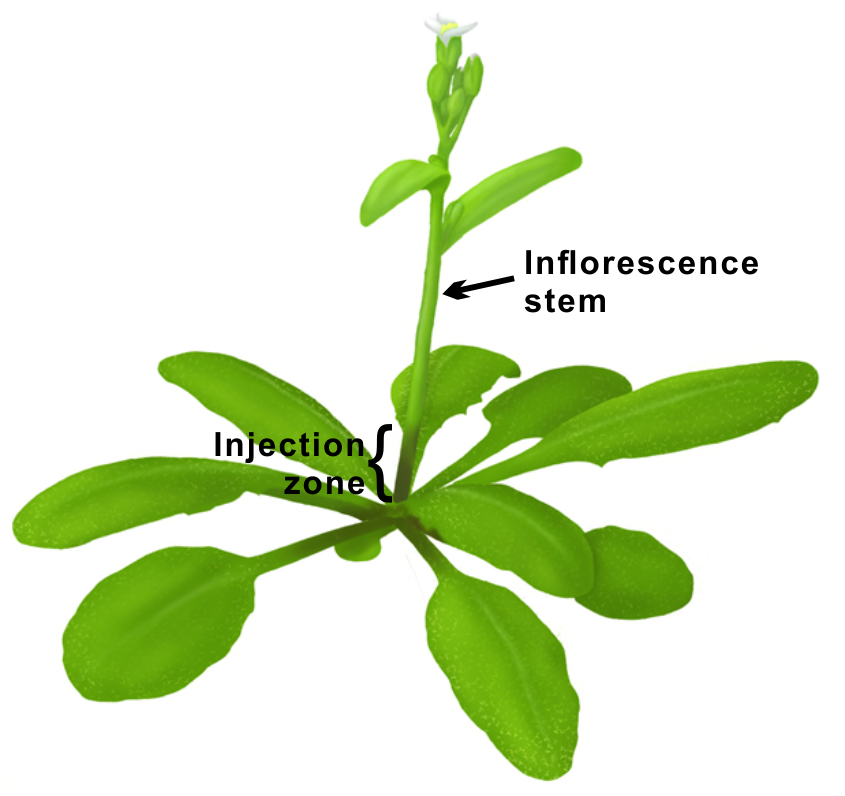
Figure 1. Schematic image of Arabidopsis influrecence stem. Young inflorescence stems were injected with a syringe in the injection zone (marked). The original Arabidopsis image is from website (http://www.lookfordiagnosis.com/mesh_info.php?term=Arabidopsis&lang=1).
- The stems were injected eight times in total, so usually eight blocks of tumors were generated at 25 days after inoculation (Figure 2). The tumors were cut from the stems with a scalpel and tweezer under a dissecting microscope Leica MZ6 and weighed in the balance.
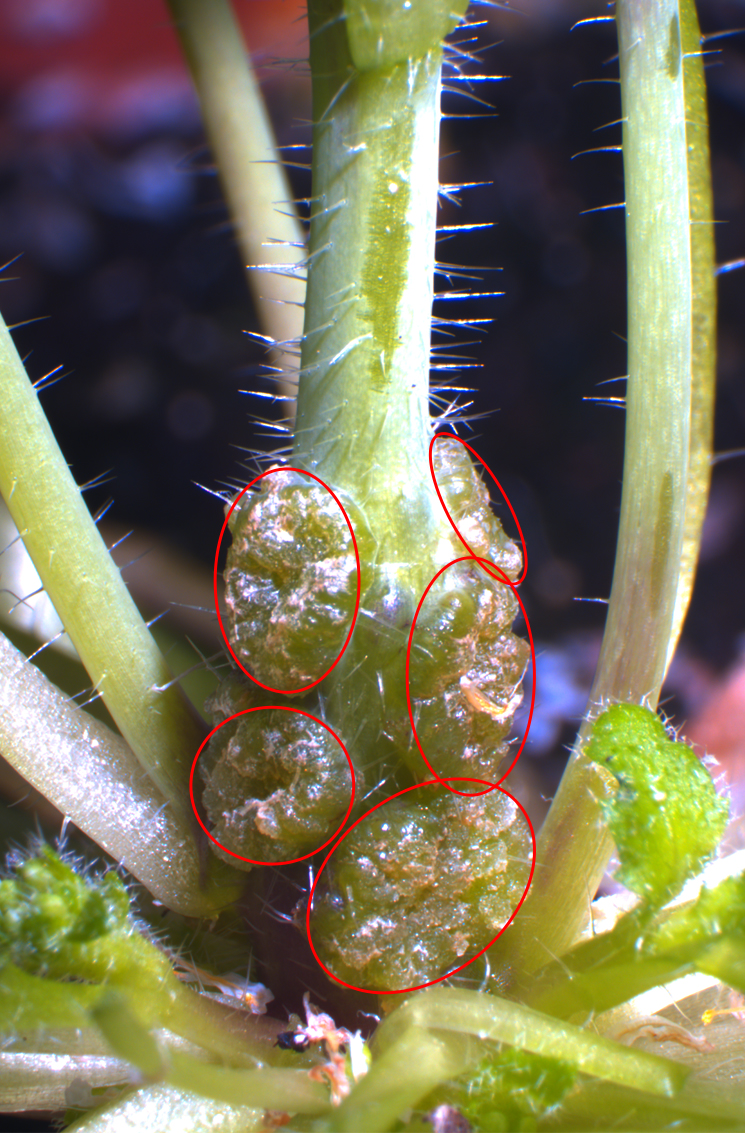
Figure 2. Arabidopsis crown gall tumors. The crown gall tumors were generated from the Arabidpsis stems at 25 days after inoculation. The tumors (marked by red circle) were cut with a scalpel and tweezer and weighed.
- Overnight culture of A. tumefaciens was obtained from colonies grown on KB agar plates. Colonies were transferred into 3-5 ml KB liquid medium in 13 ml culture tubes with assembled two-position ventilation cap (with position 1: Cap lightly pushed on, ventilated) and incubated at 140 rpm in a rotary shaker at 28 °C for overnight.
- Poly-A-mRNA extraction
Approximately 50 mg crown gall tumor was used for mRNA extraction. Poly-A-mRNA was isolated by the oligonucleotide Poly-dTTP (25) bound to polystyrene beads. Dynabeads Oligo-[dT] 25 kit was used.
- The plant tissue was frozen in liquid nitrogen and homogenized in a ball mill, and then 1 ml Lysis Buffer was added and the samples were further homogenized for 1-2 min at room temperature until the tissue was completely lysed. The lysate was centrifuged for 30 sec at 10,000 rpm.
- The manufacturer’s protocol of Dynabeads Oligo-[dT] 25 kit was performed. The supernatant was incubated for 30 min with 20 µl Dynabeads at room temperature in an overhead rotor. The tubes were place on the MagneSphere® Technology Magnetic Separation Stands for 2 min and removed the supernatant. The manufacturer’s protocol for the magnetic stand was performed.
- The first washing step: The Dynabeads were washed twice with 200 µl Washing Buffer A, and twice with 200 µl Washing Buffer B. The magnet was used to separate beads and supernatant for each washing. The Dynabeads were washed by gently flicking the bottom of the tube until all beads were resuspended, and then the beads were captured by magnetic stand. The supernatant was removed without disturbing the beads.
- In order to exclude DNA contaminations, the mRNA was eluted from the beads by 50 µl Elution Buffer and incubation at 75 °C for 2 min.
- The second washing step: 50 µl 2x Binding Buffer was added to the eluted mRNA, and the 100 µl of mixture was again incubated 20 min at room temperature in an overhead shaker.
- After two washing steps with 200 µl Washing Buffer B, the mRNA was eluted from the magnetic beads with 22 µl Elution Buffer at 75 °C for 2 min. The concentration of mRNA was quantified by NanoDrop 2000c UV-Vis Spectrophotometer. The mRNA was directly used for first-strand cDNA synthesis for 5’ RACE assay or stored at -80 °C.
- The plant tissue was frozen in liquid nitrogen and homogenized in a ball mill, and then 1 ml Lysis Buffer was added and the samples were further homogenized for 1-2 min at room temperature until the tissue was completely lysed. The lysate was centrifuged for 30 sec at 10,000 rpm.
- 5’- rapid amplification of cDNA ends (5’ RACE) assay
5’ ends of the oncogenes cDNA were amplified by SMARTer™ RACE cDNA Amplification Kit. First-Strand cDNA was generated by SMARTScribe™ Reverse Transcriptase and primed using SMARTer II A Oligonucleotide and 5'-CDS Primer A.
- The following reagents were added in one tube
2.75 µl mRNA
1.0 µl 5'-CDS Primer A
The reagents were mixed well by pipet and incubated the tubes at 72 °C for 3 min, and then 42 °C for 2 min.
- The following reagents were to the mixture from step a for a total volume of 10 µl
1.0 µl SMARTer II A Oligonucleotide
2.0 µl 5x First-Strand Buffer
1.0 µl DTT (20 mM)
1.0 µl dNTP Mix (10 mM)
0.25 µl RNase Inhibitor (40 U/μl)
1.0 µl SMARTScribe™ Reverse Transcriptase (100 U)
The reagents were mixed well by pipet and incubated the tubes at 42 °C for 90 min.
- The reaction mixture was heated at 70 °C for 10 min to terminate the reaction and the first-strand reaction product was diluted with 10 folds ddH2O. Samples were stored at -20 °C or used for next step directly.
- The following reagents were added in one tube
- Amplification and sequencing of 5’ ends of the oncogenes cDNA
- The fragments of 5’ ends of the oncogenes cDNA were amplified by DreamTaq DNA Polymerase and primed using Universal Primer A Mix (UPM) and specific target primer (Table 1) as shown in the following reaction mixture.
PCR reaction (a total volume of 50 µl):
cDNA from step 3.3.1 1 µl
5x Buffer 10 µl
10x Universal Primer A Mix 5 µl
Specific target reverse primer (10 µM) 1 µl
dNTP (10 mM) 1 µl
DreamTaq DNA Polymerase 0.5 µl
ddH2O to a final volume of 50 µl
PCR program:
Step 1: 95 °C 1 min
Step 2: 95 °C 30 sec
Step 3: 55 °C 30 sec
Step 4: 72 °C 15 sec
Step 5: repeat step 2-4 for 30 cycles
Step 6: 72 °C 5 min
Step 7: 4 °C Store
Table 1. Specific oncogene reverse primer
Gene name (Accession No.)
Primer sequence (5’ → 3’)
IaaH (pTiC58, AE007871)
CCCCGATTGCTAACAGACG
IaaM (pTiC58, AE007871)
CAAGAGTGTTCGAGAGG
Ipt (pTiC58, AE007871)
TCCCATGAATCAACTTAT
- The PCR products were purified by QIAquick PCR Purification Kit.
- The purified PCR products were inserted into pGEM-T Easy Vector by TA cloning.
2x Rapid Ligation Buffer 5 µl
pGEM-T Easy Vector (50 ng/ µl) 0.5 µl
PCR product 3.5 µl
T4 DNA Ligase 1 µl
The reagents were mixed by pipet and incubated for 1 h at room temperature.
- The resulting recombinant vectors from step 4c were transformed into E. coli strain MRF’ using the heat shock method.
- More than three independent colonies were sequenced for 5’ end of the PCR products, which were the transcription start sites of oncogene.
- The fragments of 5’ ends of the oncogenes cDNA were amplified by DreamTaq DNA Polymerase and primed using Universal Primer A Mix (UPM) and specific target primer (Table 1) as shown in the following reaction mixture.
Representative data
Table 2. Cis-regulatory sequence elements within the oncogene promoters
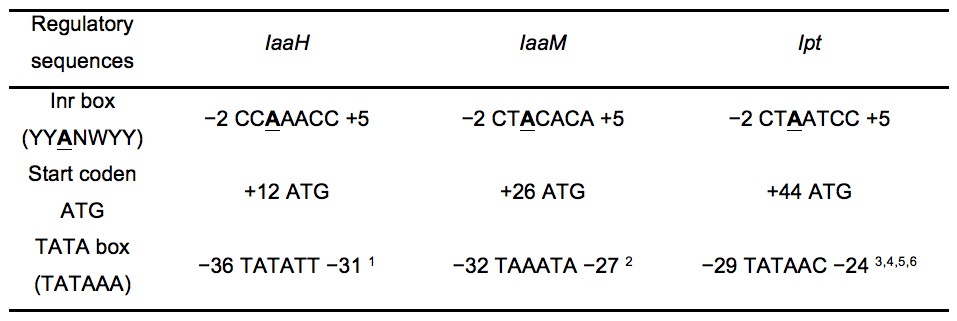
This data was published on PLOS Pathogens (Zhang et al., 2015). Positive numbers indicate the positions downstream and negative numbers the positions upstream of the TSSs (+1). TSS is underlined. Y = C/T, W = A/T, N = A/G/C/T. 1. (Klee et al., 1984); 2. (Nester et al., 1984); 3. (Goldberg et al., 1984); 4. (Heidekamp et al., 1983); 5. (de Pater et al., 1987); 6. (Lichtenstein et al., 1984)
Recipes
- KB medium
20 g protease peptone
1.5 g K2HPO4
0.87% glycerol
600 µM MgSO4
15 g agar (plate only)
Sterilized by autoclave
- Agromix buffer
0.01 M MgCl2
0.01 M MES
pH 5.6
- Lysis buffer
100 mM Tris-HCl (pH 7.5)
500 mM LiCl
10 mM EDTA
1% LiDS
5 mM dithiothreitol (DTT)
If any precipitation is observed, warm the buffer to room temperature and shake until all the components are fully resuspended.
- Washing buffer A
10 mM Tris-HCl (pH 7.5)
0.15 M LiCl
1 mM EDTA
0.1% LiDS
- Washing buffer B
10 mM Tris-HCl (pH 7.5)
0.15 M LiCl
1 mM EDTA
- Elution buffer
10 mM Tris-HCl (pH 7.5)
- 2x binding buffer
20 mM Tris-HCl (pH 7.5)
1.0 M LiCl
2 mM EDTA
Acknowledgments
I would like to thank Rosalia Deeken (Department of Molecular Plant Physiology and Biophysics, University of Wuerzburg, Germany) for supervision of this work and China Scholarship Council (CSC) for my financial support. I would also like to give many thanks to Shiqiang Gao (Department of Molecular Plant Physiology and Biophysics, University of Wuerzburg, Germany) for help, suggestion and sharing reagents.
References
- de Pater, B. S., Klinkhamer, M. P., Amesz, P. A., de Kam, R. J., Memelink, J., Hoge, J. H. and Schilperoort, R. A. (1987). Plant expression signals of the Agrobacterium T-cyt gene. Nucleic Acids Res 15(20): 8267-8281.
- Goldberg, S. B., Flick, J. S. and Rogers, S. G. (1984). Nucleotide sequence of the tmr locus of Agrobacterium tumefaciens pTi T37 T-DNA. Nucleic Acids Res 12(11): 4665-4677.
- Heidekamp, F., Dirkse, W. G., Hille, J. and van Ormondt, H. (1983). Nucleotide sequence of the Agrobacterium tumefaciens octopine Ti plasmid-encode d tmr gene. Nucleic Acids Res 11(18): 6211-6223.
- Klee, H., Montoya, A., Horodyski, F., Lichtenstein, C., Garfinkel, D., Fuller, S., Flores, C., Peschon, J., Nester, E. and Gordon, M. (1984). Nucleotide sequence of the tms genes of the pTiA6NC octopine Ti plasmid: two gene products involved in plant tumorigenesis. Proc Natl Acad Sci U S A 81(6): 1728-1732.
- Lichtenstein, C., Klee, H., Montoya, A., Garfinkel, D., Fuller, S., Flores, C., Nester, E. and Gordon, M. (1984). Nucleotide sequence and transcript mapping of the tmr gene of the pTiA6NC octopine Ti-plasmid: a bacterial gene involved in plant tumorigenesis. J Mol Appl Genet 2(4): 354-362.
- Nester, E. W., Gordon, M. P., Amasino, R. M. and Yanofsky, M. F. (1984). Crown gall - a molecular and physiological analysis. Annual Review Of Plant Physiology And Plant Molecular Biology 35: 387-413.
- Zhang, Y., Lee, C. W., Wehner, N., Imdahl, F., Svetlana, V., Weiste, C., Droge-Laser, W. and Deeken, R. (2015). Regulation of oncogene expression in T-DNA-transformed host plant cells. PLoS Pathog 11(1): e1004620.
Article Information
Copyright
© 2015 The Authors; exclusive licensee Bio-protocol LLC.
How to cite
Readers should cite both the Bio-protocol article and the original research article where this protocol was used:
- Zhang, Y. (2015). 5’ Rapid Amplification of cDNA Ends (5’ RACE) of Agrobacterial T-DNA Genes within Transformed Plant Sample. Bio-protocol 5(18): e1603. DOI: 10.21769/BioProtoc.1603.
- Zhang, Y., Lee, C. W., Wehner, N., Imdahl, F., Svetlana, V., Weiste, C., Droge-Laser, W. and Deeken, R. (2015). Regulation of oncogene expression in T-DNA-transformed host plant cells. PLoS Pathog 11(1): e1004620.
Category
Plant Science > Plant molecular biology > DNA > Gene expression
Plant Science > Plant transformation > Agrobacterium
Molecular Biology > DNA > PCR
Do you have any questions about this protocol?
Post your question to gather feedback from the community. We will also invite the authors of this article to respond.
Share
Bluesky
X
Copy link


